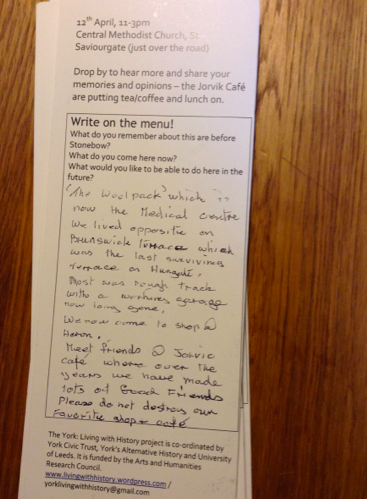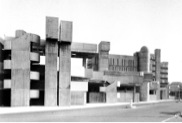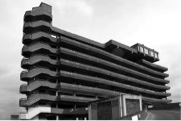There doesn’t seem to be one killer argument for keeping Stonebow House. The ‘Nos’ are always more numerous and definitive. Yet – as we found at the Stonebow House: Past, Present and Future event on 26th July – there might be a certain power in the cumulative effect of lots of different arguments.
A little recap and update. We know the City of York Council Cabinet planned on 7th January 2014 to buy the freehold for the land Stonebow House is built on. We know Stonebow House is listed as a ‘detractor’ in York Central Historic Core Conservation Area Appraisal that it should be ‘replaced by [a building] that better responds to the Conservation Area’s characteristics’ (2011, p. 467). We know draft Local Plan emphasizes Stonebow and Hungate as future retail space (June 2013). We’ve heard that the current longterm leaseholder is considering their options. So at this point nothing might change or everything might. What we do know is that if the long term leaseholder wanted to act, any development proposed could be facilitated by the CYC as landowner and planning authority and current policy appears to support in an improvement in appearance in the short term and, with a longer view, a redevelopment of the site. And so there’s no time like the present to experiment with as open, dynamic and plural ‘engagement’ processes around Stonebow House.
Thirty-two of us gathered at the Central Methodist Church on 26th July to explore further the arguments and approaches we started to identify and explore in our first event on 12th April. Before 12th April a team of us worked on exploring the pasts of the site. Martin Bashforth pulled together the various histories of Hungate with a more detailed look at 1911 census and call for photographs via York Past and Present facebook site. Another cluster of us did some work with current uses, holding a stall outside Heron Foods, spending time with the Jorvik café regulars and outside Fibbers. On the day of the event – partially to encourage people over to the event and to give an alternative space for sharing views – we set up Jorvik café history menus.

One of the public stalls run outside of Heron Foods in advance of The Stonebow Inquiry on 12th April 2014
What struck me very clearly when spending time with various groups who use Stonebow House was that ‘public meetings’, in the style we’d set up, were not for everyone. Everyone who paused for a chat outside Heron Foods wanted to talk and debate the issues but not one of those I spoke to came to the meeting itself. Instead the meeting on 12th April attracted a range of people who like meetings and, as someone said it me when I was reflecting on this, ‘are good at them’. Public meetings are not everyone’s style and, we realized, can’t be used as the only means of enabling participation.
All of these experiences shaped our planning for 26th July. Firstly we knew we hadn’t really grasped the architectural question fully. So thanks to Gill Chitty, University of York and Peter Brown, York Civic Trust I was put in contact with Jon Wright, freelance architectural historian and former Senior Caseworker for the Twentieth Century Society and, until 2013, Head of Conservation at the Council for British Archaeology in York. Jon is fantastically knowledgeable about brutalist architecture and had an interesting take on Stonebow House. So through our York: Living with History blog, York Mix, and ultimately York Press, Jon published his take which set out a number of arguments for why York should recognize the value of Stonebow House. Following the blog and article’s wide publication, Jon and I also started to ‘run the arguments’ through the dynamic York Past and Present facebook page to explore which arguments resonated – and which didn’t.

York Past and Present was a space which generated a lot of debate. Rex Barley’s arguments were focused on the dangers of a minority who liked the building outweigh what he saw as the massive majority who see Stonebow House as an eyesore. As Rex couldn’t attend the meeting we agreed I’d print out his comments to share.
Alongside this Lisa, from York Stories returned to her long time interested in Stonebow House. Lisa’s very layer and poetic response has been, since 2004, to see it as a place which somehow defies what is expected of York – burnt our cars and graffiti. In the run up to the 26th July meeting, Lisa also asked her regular readers views of Stonebow House – including three words to sum it up, some of which are pictured here.
Before we all met, I did a summary of the arguments which I shared with those registering, we also posted a selection of comments representing these different arguments on the wall, alongside Lisa’s readers ‘Stonebow House in three words’. The event itself was, then informed and shaped by lots of people who couldn’t, or wouldn’t want to, come to meet us at Central Methodist Church on a Saturday afternoon.
The Living with History event itself began with Jon opening up the issues from his perspective. There were some challenges from the floor immediately – specifically focused on the question of whether Jon thought the building was of high enough quality to be listed by English Heritage. As in the blog, Jon was clear that probably, on balance, it wouldn’t meet the English Heritage listing criteria of being of sufficient ‘architectural or historic interest’ (EH website). However, Jon made a number of others arguments:
• It’s a very York issue: ‘Coming from the station I was struck by how modest it is. It is a building which would go overlooked in lots of other places. But not in York’.
• Memorable: ‘It’s a prominent landmark’
• Tastes go round in cycles: There is a danger of it being lost now without a chance for it to come back into vogue.
• Very few other good examples from 20th Century: Shows the 1960s happened in York too.
• Capital ‘A’ architecture: Form is its function – better than pastiche or buildings that aren’t memorable at all.
Jon recognized that the building does have its problem at street level – but that there is a lot of potential for reuse.
Having heard Jon’s account, everyone went out into the sun to have another look at the building. Quite a few people went up to the carpark area, others tried to stand back and look at it from street level.

One of 40 ‘three words on Stonebow House’ contributed via York Stories and at the event on 26th July.
We then reconvened in small groups in continue the discussion. Key arguments in favour of complete redevelopment:
• Contexts: ‘Doesn’t fit into it’s context’. ‘Can we put it on wheels and take it to the university; (the argument made for it being a distractor in CYC Conservation Area Appraisal).
Arguments for evolution / reuse of the building – started pragmatically and moved on to environmental questions:
• Would anything better go in it’s place?: Could be worse…
• It’s in good condition: Noted the concrete is in good nick.
• Historical importance – in spite of itself: ‘the building is important because it became a symbol of why York needed to be good at conservation!’
• York’s made up of lots of little bits of history: why not have a 20th Century bit too?
• Environmental costs of demolishing the building
One participant did want to consider English Heritage listing. Yet another made a strong case for keeping the decision as local as possible:
• Users not academic interest: ‘This is not a matter of academic interest (is it good architecture). It should be decided by English heritage. What really matters is the people of York. The real question is does it serve local interests’.
These reflected arguments made on facebook, comments on blogs/articles and via the York Stories survey. Yet it was noticeable how pragmatic the small group discussions seemed to have become by the end of the meeting. It was as if the fact of the building had been accepted and people had moved onto what to do about it. There were lots of constructive ideas about reuse. Lots of ideas of gardens in the sky. Or about affordable housing in the tower. There is clearly not one argument that is generally thought to be convincing – but the power of lots of smaller ones seemed to add up to something.
There are two comments made in the room which seemed to sum up this emerging sense that the issues around Stonebow House are not at all clearcut. The first, was, ‘it’s a bit like the more you interact with it, the more friendly it becomes’. And finally ‘it’s ours!’ Love it, hate it…Stonebow House is now part of York. It is now our responsibility and, one way or the other, the feeling of the meeting was that we wanted to accept that responsibility, together and locally.




















